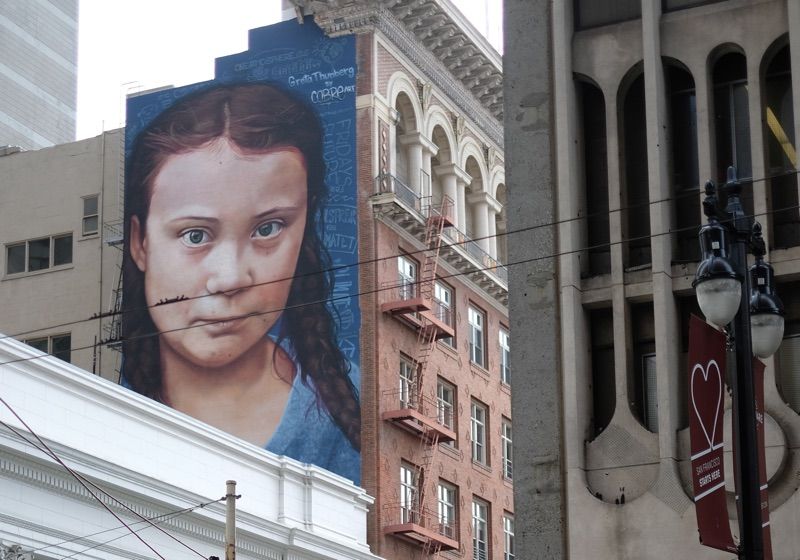The man-made causes and severe consequences of climate change have been researched extensively and have been known to the broader public for decades. However, sufficient political and individual action to stop the development is still not in sight. One of the reasons is in my opinion the fact that climate change and its mitigation has not been presented as a strong brand people want to engage with.
Greta Thunberg and the re-branding of Climate Change
Back in 2018, we could witness a new phenomenon emerge: Greta Thunberg, the young Swedish climate activist. Her visual presence gave climate change a new face and dominated the climate discourse in the years 2018 to 2019 to such an extent, that the public would automatically connect the topic of climate change with her and the Fridays For Future movement. Climate change had been rebranded: it was no longer perceived as a distant, scientific problem, but the most urgent challenge, which required immediate global action.
In 2018, then 15-year-old Greta Thunberg started her first school strike for the climate in front of the Swedish Parliament in Stockholm. It would become the first step in changing the narrative about climate change and result in the world history’s biggest climate demonstration with millions of participants only one year later.
In my research, I analyzed a selection of Thunberg’s most significant and widely shared pictures to define how her image was constructed from a branding perspective. Her visual representation is mainly composed of three images.
1) Thunberg as a young girl, who looks partly uncomfortable, vulnerable, or innocent on the pictures, 2) Thunberg as a strong young woman fighting confidently – and sometimes loud and aggressively – for her cause, and 3) Thunberg as the knowledgeable prophet, who dedicates her life to the cause, inspiring her loyal followers to do the same.
Together, these three images compose a diverse yet coherent public image of Greta Thunberg.
I also see how every photograph reproduces the sense of urgency and authenticity that surrounds her activism.
Triggers for concrete policy measures
These characteristics form the foundation for the activist Greta Thunberg as a strong brand, in which her personal identity and the way she herself and most media represent her visually produce persuasive images for the audience.
Due to her dominance over the visual discourse of climate change in recent years, it can be argued that she redefined the climate change brand with her look, her voice, her arguments, and her actions – thereby putting the issue into the spotlight as never before.
What followed was tangible political action, such as the European Green Deal, but also increased awareness and behavioural changes by many individuals to do their part in mitigating climate change by e.g., reducing flights, eating vegetarian diets, or shopping second-hand clothes.
When Covid-19 spread around the world in early 2020, it naturally moved to the top of the agenda of politicians and media. The pandemic revealed how quickly governments can pass radical legislation and implement widespread policies – not to mention the financial bailouts – to mitigate a crisis. And citizens around the world were ready to dramatically change their individual behaviour by wearing masks, keeping a distance to other people in public, and reducing their social contacts from one day to the other.
Climate change and COVID-19 are both deadly global crises that require immediate and widespread action by politics, businesses, and individuals.
So why did we managed to cope with COVID-19 so quickly? How could we suddenly embrace all these changes and adopt our behaviour when politicians had always told us that radical change was impossible? Why have we not yet applied similar mechanisms to stop climate change?
An important reason is certainly the immediate threat to the lives of people that came like a wave to all corners of the world. But the pandemic’s branding is crucial as well, and the pictures representing it, which shook us all emotionally and increased our fears.
In their core identities, COVID-19 and climate change are comparable to some extent as they are a danger to the lives of millions of people.
But while COVID-19 spreads visibly around the world and is relatively easy to communicate and brand, climate change is more complex and requires more background knowledge about the various causes and interconnected consequences to truly develop compelling communications and a strong brand around it.
Before the Fridays For Future movement, climate change was mostly represented by scientific articles or pictures of polar bears, melting icecaps, or smoking industrial chimneys; all subjects related to climate change but also a visual representation that fosters the perception of climate change as a remote issue. Not strong enough to motivate behavioral change of people in the Global North, who bear the primary responsibility for CO2 emissions.
Corona-Crisis was collectivly branded
But even though Greta Thunberg and the Fridays For Future movement were a wake-up call for many that provoked more climate action, it was not enough to engage all people like COVID-19 does. The pandemic reached all corners of the world and was branded collectively. It has severe consequences to – broadly speaking – everyone, which makes it more scary.
The threatening identity of COVID-19 was communicated through strong pictures, which had a lasting effect on us.
Who would not be touched by the photographs of nurses and doctors working tirelessly against the virus to save patients’ lives? Exhausted patients suffering and dying in their hospital beds without the chance of saying goodbye to their loved ones. Military trucks carrying away the coffins from hospitals. Improvised morgues and anonymous mass graves in all parts of the world. This list could go on.
These photographs are frightening and have burned themselves into our collective memory. They show the harsh truth of the pandemic, and, yes, they contribute to positioning COVID-19 as a strong – yet terrible – brand in all of our heads.
Facing this reality can help us move forward and learn from the pandemic.
This article argued that branding theory could help us break down complexity and offer an understanding of the different crisis responses to COVID-19 and climate change. Since visuality plays such an important role for the brand image and the engagement with the brand, it could be asked whether we should paint a more dramatic picture and share more severe photographs of the consequences of climate change to provoke more action?
Certainly not.
The harsh visuality of the pandemic made a strong impression on people and created the necessary quick action from everyone in the short run, but it is not a model to be replicated.
Yes, we must strengthen climate change and its mitigation as a brand, but we should not add more negative energy to the exhaustion and mental tension of people. The shock of the pandemic will be in us for a long time ahead.
We must now seize the moment and create positive stories of change to inspire people and restore their hope in a better future.
Only if we create a positive brand of climate change mitigation will we succeed in engaging enough people to join the journey. If not, the next global crisis will be just around the corner with even more dramatic and irreversible consequences for all of us.
The author holds an MA in Visual Culture from the University of Copenhagen and a BA in Political Science and Communication Studies from LMU Munich. He graduated with a thesis exploring the rebranding of climate change by Greta Thunberg. The author also works as a consultant for Dalberg Media with sustainability, global development, and communications. You can reach the author at loeken.philipp@gmail.com.



















